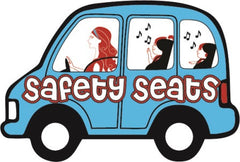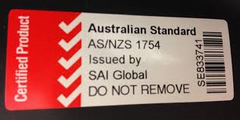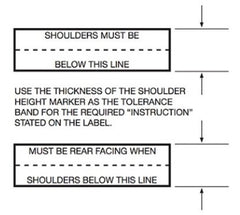Let's talk about car seats!
Guest Bundle blogger, Stefanie from Safety Seats, shares some of her top tips for making sure your most precious bundle is safe whenever you take a drive.
 Hi, I’m Stefanie, owner of Safety Seats. I’m an accredited child restraint fitter and a mum of two children. Knowing how to install a car seat and how to use it safely is a must. In Australia, three out of four car seats are not installed correctly and, according to the Monash Accident Research Centre, almost 50% of the restraints fitted by parents have harness straps twisted, are badly fitted or in the wrong position. That is a staggering statistic when you consider the danger that puts your child in!
Hi, I’m Stefanie, owner of Safety Seats. I’m an accredited child restraint fitter and a mum of two children. Knowing how to install a car seat and how to use it safely is a must. In Australia, three out of four car seats are not installed correctly and, according to the Monash Accident Research Centre, almost 50% of the restraints fitted by parents have harness straps twisted, are badly fitted or in the wrong position. That is a staggering statistic when you consider the danger that puts your child in!
There are so many car seats available now that the choice can be overwhelming. We are fortunate in Australia that our safety standards are some of the highest in the world, but unfortunately our laws are still somewhat lagging. Luckily, safety research, education and recommendations from leading organisations are gaining strength, giving parents the knowledge to choose the safest option rather than just the legal minimum.
Depending on the age and height of your child, it is safest to keep them rear facing for as long as possible, then in a harnessed seat also for as long as possible, and finally in a booster seat until they grow out of it.
When purchasing a car seat, there are a few key points to consider:
- Ensure the car seat is Australian Standards Certified. Using an overseas restraint in Australia is illegal and unsafe. It must contain this logo:

- Ideally, always purchase new so that you are aware of the history of the seat. If you must use a second hand seat, ensure it is no more than ten years from the date of manufacture, has not been in an accident and contains all original pieces.
- Make sure the seat is suitable for your child’s age/height. There are different categories of seats that have different features depending on the age of the child and their needs - a step up in category prematurely is a step down in safety. Always use the correct restraint to its maximum (i.e. a 12mth old child should be using a 0-4yrs restraint until it has outgrown it rather than changing to a 6mths-8yrs restraint early).
- Test it in your car! Every vehicle and car seat is different, it is important to ensure you get the best fit possible before purchasing.
- Look at your overall needs. Do you need to fit more than one restraint in the vehicle, are you limited for space, does your child have a long torso measurement? These factors will need to be considered so that you can purchase a seat that has a slim width, shorter depth, higher seat markers etc.
Once you have a car seat, it’s time to install it. Contrary to popular opinion, it isn’t difficult… but it does need to be done correctly! Whilst there is no legal requirement to use a professional to install your car seat, if you are unsure, it is a good idea to at the very least have them inspect it. Any issues, however minor they may seem, can ultimately render the car seat unsafe in an accident.
There are a few key points to consider:
- READ THE INSTRUCTIONS! I cannot stress this enough. All seats come with an instruction manual (or they can be found online if not) and will have installation and use instructions printed on the side of the restraint.
- Set the seat up correctly for the child. When rear facing, straps should always be level or above the shoulders, and when forward facing they should be as close to the shoulders as possible. If your seat has an additional head restraint, it should be situated around the base of the ears and not touching the shoulders. Any additional padding that came with the seat can be removed if/when required to obtain the best fit. The straps should always be tightened firmly against the child’s body. No aftermarket products should ever be used.
 Install the seat as per the instructions for either rear facing or forward facing dependant on the child’s seated height. There are height markers (pictured below) that must be adhered to in addition to the legal minimums (<6mths must be rear facing; 0-4yrs must be rear or forward facing in a harnessed seat; 4yrs-7yrs must be forward facing in a harnessed seat or booster seat). If your child has not yet reached the forward facing marker, you should continue to rear face them until they do. The same goes for using a harnessed seat vs booster seat.
Install the seat as per the instructions for either rear facing or forward facing dependant on the child’s seated height. There are height markers (pictured below) that must be adhered to in addition to the legal minimums (<6mths must be rear facing; 0-4yrs must be rear or forward facing in a harnessed seat; 4yrs-7yrs must be forward facing in a harnessed seat or booster seat). If your child has not yet reached the forward facing marker, you should continue to rear face them until they do. The same goes for using a harnessed seat vs booster seat.- Ensure that the seatbelt is threaded through the correct belt path and fastened firmly. A locking clip can be used to secure the seatbelt if your car does not have automatic locking seatbelts. If using an Isofix compatible seat, ensure the connectors are attached and showing green on both indicators. Isofix is only available in the 2 outboard positions and only in 0-4yrs seats in Australia. It is no safer than a correct seatbelt installation but can be easier to use.
- When rear facing, the restraint should be reclined to a 40-45° angle. This prevents the child from having head flop which can cause asphyxiation. An app can be downloaded on your smartphone, and to test this, place your phone in the seat where the child’s back sits. Some vehicles have deep seats that may prevent you from obtaining an optimal installation or angle. In these instances, a tightly rolled towel may be used at the base of the vehicle seat to increase the angle. However, always consult your manual before altering an installation.
- Connect the tether strap to the correct anchor point. If this is not clearly indicated, consult your vehicle manual. All Australian seats (except for untethered boosters) MUST use a tether strap. It should not be twisted (a half twist when rear facing is acceptable) and should be firm but not over tight.
- The safest place to install a car seat is wherever you get the best fit. It should not touch the seats in front and should be firm and stable on the vehicle seat.
Whilst this all sounds very daunting and confusing, I assure you, it’s not. There’s no such thing as a “stupid” question when it comes to child restraints so if in doubt, ASK FOR HELP! I highly recommend doing plenty of research and consulting a professional child restraint fitter or organisation such as the Australian Child Restraint Resource Initiative or Kidsafe to obtain the correct information and assistance in choosing and installing your car seat. After all, you can’t put a price on the safety of your child!




 Buy Now, Pay Later
Buy Now, Pay Later Fast delivery
Fast delivery Free returns
Free returns
 Install the seat as per the instructions for either rear facing or forward facing dependant on the child’s seated height. There are height markers (pictured below) that must be adhered to in addition to the legal minimums (<6mths must be rear facing; 0-4yrs must be rear or forward facing in a harnessed seat; 4yrs-7yrs must be forward facing in a harnessed seat or booster seat). If your child has not yet reached the forward facing marker, you should continue to rear face them until they do. The same goes for using a harnessed seat vs booster seat.
Install the seat as per the instructions for either rear facing or forward facing dependant on the child’s seated height. There are height markers (pictured below) that must be adhered to in addition to the legal minimums (<6mths must be rear facing; 0-4yrs must be rear or forward facing in a harnessed seat; 4yrs-7yrs must be forward facing in a harnessed seat or booster seat). If your child has not yet reached the forward facing marker, you should continue to rear face them until they do. The same goes for using a harnessed seat vs booster seat.
Leave a comment